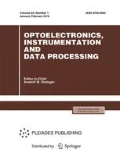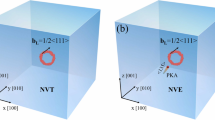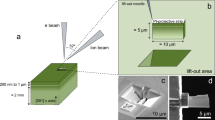Abstract
The structure of extended defects introduced into Si by means of boron implantation followed by thermal annealing at T = 900 °C is studied by the method of high-resolution transmission electron microscopy and computer modeling for different values of the implantation dosage (D) and concentration of boron atoms in substitutional positions B0 \((C_{B_0 } )\) injected into the Si lattice before implantation. It is shown that the Frank dislocation loops of both interstitial (I) and vacancy (V) type at a ratio of 4: 1 are observed in Si samples with D = 1016 cm−2 up to \(C_{B_0 } \) = 0.8·1020 cm−3. The atomic structure of the I-type Frank dislocation loops is heavily deformed, which suggests segregation of finely dispersed boron in the defect plane. At the same time, the structure of the V-type Frank dislocation loops tends to be reconstructed due to interaction with self-interstitials. At \(C_{B_0 } \) = 2.5·1020 cm−3, the I-type Frank dislocation loops are found to transform to perfect dislocation loops, and boron precipitates with a high density appear in Si. Based on the results obtained, probable reasons for vacancy deficit formation in boron-implanted Si are discussed.
Similar content being viewed by others
References
M. D. Giles, “Transient Phosphorus Diffusion below the Amorphization Threshold,” J. Electrochem. Soc. 138(4), 1160–1168 (1991).
D. J. Eaglesham, P. A. Stolk, H.-J. Gossmann, and J. M. Poate, “Implantation and Transient B Diffusion in Si: The Source of the Interstitials,” Appl. Phys. Lett. 65(18), 2305–2307 (1994).
A. Aseev, L. Fedina, D. Hoehl, and H. Barsch, Clusters of Interstitial Atoms in Silicon and Germanium (Academy Verlag, Berlin, 1994).
S. Libertino and A. La Magna, “Damage Formation and Evolution in Ion-Implanted Crystalline Si,” in: Materials Science with Ion Beams (edited by H. Bernas), Ser. Topics in Applied Physics, Vol. 116, pp. 147–212 (2010).
R. Kalyanaraman, V. Venezia, L. Pelaz, et al., “Enhanced Low Temperature Electrical Activation of B in Si,” Appl. Phys. Lett. 82(2), 215–217 (2003).
K. V. Feklistov, L. I. Fedina, and A. G. Cherkov, “Boron Precipitation in Si during High-Dosage Implantation,” Fiz. Tekhn. Polupr. 44(3), 302–305 (2010).
A. L. Aseev, M. Tsigler, and L. I. Fedina, “On the Structure of Oxidation Stacking Faults,” Poverkhnost. Fisika, Khimiya, Mekhanika, No. 10, 70–79 (1986).
L. Fedina, A. Gutakovskii, A. Aseev, et al., “Extended Defects Formation in Si Crystals by Clustering of Intrinsic Point Defects Studied by In-Situ Electron Irradiation in an HREM,” Phys. Status Solidi A 171(1), 147–157 (1999).
S. Duguay, T. Philippe, F. Cristiano, and D. Blavette, “Direct Imaging of Boron Segregation to Extended Defects in Silicon,” Appl. Phys. Lett. 97(3), 242104–242107 (2010).
L. Fedina, A. Gutakovskii, A. Aseev, et al., “On the Mechanism of {111} Defect Formation in Silicon Studied by In Situ Electron Irradiation in a High Resolution Electron Microscope,” Phil. Mag. A 77(2), 423–435 (1998).
L. Fedina and A. Aseev, “Study of Point Defects Interaction with Dislocation in Silicon by Means of Irradiation in an Electron Microscope,” Phys. Status Solidi A 95(2), 517–529 (1986).
L. I. Fedina, S. A. Song, A. L. Chuvilin, et al., “On the Mechanism of {113}-Defect Formation in Si,” Springer Proc. Phys. 107, 359–362 (2005).
C. T. Chou, D. J. H. Cockayne, J. Zou, et al., “{111} Defects in 1-MeV-Silicon-Ion-Implanted Silicon,” Phys. Rev. B 52(24), 17223–17230 (1995).
M. Beaufort, H. Garem, and J. Lépinoux, “Microstructural Defects Induced by Implantation of Hydrogen in (111) Silicon,” Phil. Mag. A 69(5), 881–901 (1994).
D. De Salvador, E. Napolitani, S. Mirabella, et al., “Atomistic Mechanism of Boron Diffusion in Silicon,” Phys. Rev. Lett. 97(25), 255902 (2006).
K. Feklistov and L. I. Fedina, “Boron Nonuniform Precipitation in Si at the Ostwald Ripening Stage,” Physica B 404(23–24), 4641–4644 (2009).
Author information
Authors and Affiliations
Corresponding author
Additional information
Original Russian Text © L.I. Fedina, A.K. Gutakovskii, A.V. Latyshev, 2014, published in Avtometriya, 2014, Vol. 50, No. 3, pp. 34–40.
About this article
Cite this article
Fedina, L.I., Gutakovskii, A.K. & Latyshev, A.V. Atomic structure of extended defects in boron-implanted silicon layers. Optoelectron.Instrument.Proc. 50, 241–246 (2014). https://doi.org/10.3103/S8756699014030042
Received:
Published:
Issue Date:
DOI: https://doi.org/10.3103/S8756699014030042




